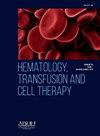PROGNOSTIC VALUE OF CD56 EXPRESSION IN CHILDREN WITH ACUTE MYELOID LEUKEMIA
IF 1.6
Q3 HEMATOLOGY
引用次数: 0
Abstract
Introduction
Expression of lymphoid markers (CD2, CD3, CD5, CD7) in Acute Myeloid Leukemia (AML) is an important prognostic factor that affects the clinical outcome of these patients. CD56 antigen is a NK cell marker that is expressed in several lymphohematopoietic neoplasms, including AML. The presence of CD56 antigen on blast cells can affect the duration of Complete Remission (CR), and is also associated with short overall survival and resistance to therapy. We studied a cohort of children diagnosed with AML treated from 2022‒2024 and assessed the association of CD56 expression with therapy outcomes.
Methodology
To determine the frequency of CD56 by flow cytometry in children with AML and to study the prognostic significance of this marker. Materials and Methods: The study included 31 patients aged 0‒16 years diagnosed from January 2022 to December 2024. The study was conducted on a BD FACS CANTO flow cytometer using an 8-color panel of monoclonal antibodies. Marker expression on blast cells of more than 20% was considered positive.
Results
СреThe total observation period was 31 months. The patients were divided into 3 age groups: 0‒5-years ‒ 5 (16%), 5‒10-years ‒ 12 (38.7%), 10‒16 years ‒ 14 (45%) patients, male ‒ 17 (54.8%), female ‒ 14 (45%). In the general observation group, 19 (62%) patients were in complete clinical and hematological remission, 10 (34%) patients had bone marrow relapse, 4% had resistance to therapy. In 7 (23%) cases, positive expression of CD56 was observed, of which 3 (9.6%) cases of AML with signs of maturation, 1 (3%) case of promyelocytic, 3 (9.6%) cases of myelomonoblastic leukemia. Among CD56 positive AML patients, mutations such as t(8;21)(q22;q22), ct(15;17), t(11q23), inv(16) were detected. Survival analysis was performed using the Kaplan-Meier method. The achievement of complete remission in response to induction chemotherapy between CD56-positive and CD56-negative groups was almost identical (85% and 81%). Relapse-free survival between CD56 positive and negative variants was significantly different (67% vs. 48%). Among children with AML with CD56-positive, higher relapse and mortality rates were observed than in the CD56-negative group (p < 0.05).
Conclusion
We consider CD56 expression as an independent prognostic factor. It is recommended to keep in mind that the presence of this marker is associated with some cytogenetic abnormalities. CD56 is a potential factor for poor prognosis in groups of children with AML and should be taken into account when stratifying risk groups.
cd56表达在儿童急性髓性白血病中的预后价值
急性髓系白血病(AML)中淋巴标记物(CD2、CD3、CD5、CD7)的表达是影响这些患者临床预后的重要预后因素。CD56抗原是一种NK细胞标志物,在包括AML在内的几种淋巴造血肿瘤中表达。CD56抗原在母细胞上的存在可以影响完全缓解(CR)的持续时间,并且还与较短的总生存期和对治疗的耐药性有关。我们研究了一组在2022-2024年间接受AML治疗的儿童,并评估了CD56表达与治疗结果的关系。方法采用流式细胞术检测急性髓性白血病患儿CD56的表达频率,探讨该标志物的预后意义。材料与方法:研究纳入了31例年龄0-16岁的患者,时间为2022年1月至2024年12月。研究是在BD FACS CANTO流式细胞仪上进行的,使用8色单克隆抗体面板。标记物在胚细胞上的表达超过20%为阳性。ResultsСреThe总观察期31个月。患者分为3个年龄组:0- 5岁- 5岁(16%)、5- 10岁- 12岁(38.7%)、10-16岁- 14岁(45%)、男性- 17岁(54.8%)、女性- 14岁(45%)。普通观察组临床及血液学完全缓解19例(62%),骨髓复发10例(34%),治疗耐药4%。CD56阳性表达7例(23%),其中有成熟迹象的AML 3例(9.6%),早幼粒细胞1例(3%),髓母细胞白血病3例(9.6%)。在CD56阳性AML患者中,检测到t(8;21)(q22;q22)、ct(15;17)、t(11q23)、inv(16)等突变。采用Kaplan-Meier法进行生存分析。cd56阳性组和cd56阴性组对诱导化疗的完全缓解几乎相同(85%和81%)。CD56阳性和阴性变异的无复发生存率显著不同(67%对48%)。cd56阳性AML患儿的复发率和死亡率高于cd56阴性患儿(p <;0.05)。结论我们认为CD56表达是一个独立的预后因素。建议记住,该标记物的存在与一些细胞遗传学异常有关。CD56是AML患儿预后不良的潜在因素,在进行风险分组时应将其考虑在内。
本文章由计算机程序翻译,如有差异,请以英文原文为准。
求助全文
约1分钟内获得全文
求助全文
来源期刊

Hematology, Transfusion and Cell Therapy
Multiple-
CiteScore
2.40
自引率
4.80%
发文量
1419
审稿时长
30 weeks
 求助内容:
求助内容: 应助结果提醒方式:
应助结果提醒方式:


